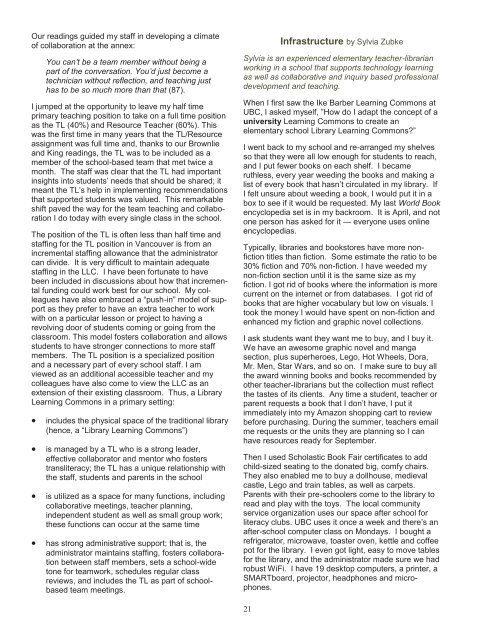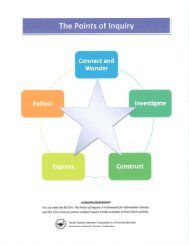FROM SCHOOL LIBRARY TO LIBRARY LEARNING COMMONS:
A source document for transforming K-12 school libraries into Library Learning Commons in BC, developed by the BC Teacher Librarians' Association
A source document for transforming K-12 school libraries into Library Learning Commons in BC, developed by the BC Teacher Librarians' Association
Create successful ePaper yourself
Turn your PDF publications into a flip-book with our unique Google optimized e-Paper software.
Our readings guided my staff in developing a climate<br />
of collaboration at the annex:<br />
You can’t be a team member without being a<br />
part of the conversation. You’d just become a<br />
technician without reflection, and teaching just<br />
has to be so much more than that (87).<br />
I jumped at the opportunity to leave my half time<br />
primary teaching position to take on a full time position<br />
as the TL (40%) and Resource Teacher (60%). This<br />
was the first time in many years that the TL/Resource<br />
assignment was full time and, thanks to our Brownlie<br />
and King readings, the TL was to be included as a<br />
member of the school-based team that met twice a<br />
month. The staff was clear that the TL had important<br />
insights into students’ needs that should be shared; it<br />
meant the TL’s help in implementing recommendations<br />
that supported students was valued. This remarkable<br />
shift paved the way for the team teaching and collaboration<br />
I do today with every single class in the school.<br />
The position of the TL is often less than half time and<br />
staffing for the TL position in Vancouver is from an<br />
incremental staffing allowance that the administrator<br />
can divide. It is very difficult to maintain adequate<br />
staffing in the LLC. I have been fortunate to have<br />
been included in discussions about how that incremental<br />
funding could work best for our school. My colleagues<br />
have also embraced a “push-in” model of support<br />
as they prefer to have an extra teacher to work<br />
with on a particular lesson or project to having a<br />
revolving door of students coming or going from the<br />
classroom. This model fosters collaboration and allows<br />
students to have stronger connections to more staff<br />
members. The TL position is a specialized position<br />
and a necessary part of every school staff. I am<br />
viewed as an additional accessible teacher and my<br />
colleagues have also come to view the LLC as an<br />
extension of their existing classroom. Thus, a Library<br />
Learning Commons in a primary setting:<br />
<br />
<br />
<br />
<br />
includes the physical space of the traditional library<br />
(hence, a “Library Learning Commons”)<br />
is managed by a TL who is a strong leader,<br />
effective collaborator and mentor who fosters<br />
transliteracy; the TL has a unique relationship with<br />
the staff, students and parents in the school<br />
is utilized as a space for many functions, including<br />
collaborative meetings, teacher planning,<br />
independent student as well as small group work;<br />
these functions can occur at the same time<br />
has strong administrative support; that is, the<br />
administrator maintains staffing, fosters collaboration<br />
between staff members, sets a school-wide<br />
tone for teamwork, schedules regular class<br />
reviews, and includes the TL as part of schoolbased<br />
team meetings.<br />
Infrastructure by Sylvia Zubke<br />
Sylvia is an experienced elementary teacher-librarian<br />
working in a school that supports technology learning<br />
as well as collaborative and inquiry based professional<br />
development and teaching.<br />
When I first saw the Ike Barber Learning Commons at<br />
UBC, I asked myself, ”How do I adapt the concept of a<br />
university Learning Commons to create an<br />
elementary school Library Learning Commons?”<br />
I went back to my school and re-arranged my shelves<br />
so that they were all low enough for students to reach,<br />
and I put fewer books on each shelf. I became<br />
ruthless, every year weeding the books and making a<br />
list of every book that hasn’t circulated in my library. If<br />
I felt unsure about weeding a book, I would put it in a<br />
box to see if it would be requested. My last World Book<br />
encyclopedia set is in my backroom. It is April, and not<br />
one person has asked for it — everyone uses online<br />
encyclopedias.<br />
Typically, libraries and bookstores have more nonfiction<br />
titles than fiction. Some estimate the ratio to be<br />
30% fiction and 70% non-fiction. I have weeded my<br />
non-fiction section until it is the same size as my<br />
fiction. I got rid of books where the information is more<br />
current on the internet or from databases. I got rid of<br />
books that are higher vocabulary but low on visuals. I<br />
took the money I would have spent on non-fiction and<br />
enhanced my fiction and graphic novel collections.<br />
I ask students want they want me to buy, and I buy it.<br />
We have an awesome graphic novel and manga<br />
section, plus superheroes, Lego, Hot Wheels, Dora,<br />
Mr. Men, Star Wars, and so on. I make sure to buy all<br />
the award winning books and books recommended by<br />
other teacher-librarians but the collection must reflect<br />
the tastes of its clients. Any time a student, teacher or<br />
parent requests a book that I don’t have, I put it<br />
immediately into my Amazon shopping cart to review<br />
before purchasing. During the summer, teachers email<br />
me requests or the units they are planning so I can<br />
have resources ready for September.<br />
Then I used Scholastic Book Fair certificates to add<br />
child-sized seating to the donated big, comfy chairs.<br />
They also enabled me to buy a dollhouse, medieval<br />
castle, Lego and train tables, as well as carpets.<br />
Parents with their pre-schoolers come to the library to<br />
read and play with the toys. The local community<br />
service organization uses our space after school for<br />
literacy clubs. UBC uses it once a week and there’s an<br />
after-school computer class on Mondays. I bought a<br />
refrigerator, microwave, toaster oven, kettle and coffee<br />
pot for the library. I even got light, easy to move tables<br />
for the library, and the administrator made sure we had<br />
robust WiFi. I have 19 desktop computers, a printer, a<br />
SMARTboard, projector, headphones and microphones.<br />
21






